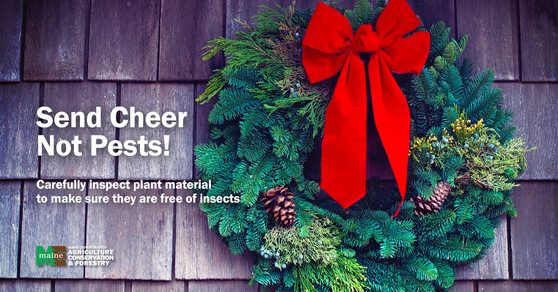|
Note to readers, a shareable holiday wreath image is included below the release.
For Immediate Release
November 18, 2022
Contacts: Sarah Scally, Jim Britt
Send Holiday Cheer, Not Pests: Follow Out-Of-State Plant Health Regulations Save time and money by sending healthy plant material and knowing shipping and labeling requirements.
AUGUSTA –Many Maine residents’ holiday celebrations are incomplete without decorating with Maine-grown wreaths, trees, and other decorative plant material. Sending wreaths and trees to our friends and families across the country can help us feel connected even if we can’t be together this holiday season. The Maine Department of Agriculture, Conservation and Forestry (DACF) reminds Mainers sending holiday greenery that they can save time and money and prevent product loss by shipping only healthy plant material.
“Shippers should be aware of the many state laws and regulations regarding the movement of plants and forest products,” warned Carole Neil, Assistant Horticulturist with DACF. “Many states closely monitor shipments to prevent the introduction of invasive insects and plant diseases. By planning, Maine shippers can speed up deliveries in this time-sensitive industry.”
DACF offers this advice for wreath and tree shippers:
-
Import regulations vary from state to state. Check destination state regulations before sending plant material. A summary of plant health regulations for Maine-grown holiday decorations is at www.maine.gov/dacf/php/horticulture/wreaths.shtml.
-
Shipping internationally? Many countries prohibit most types of plant material from being included in holiday decorations. Some countries may allow some holiday decorations with the proper certification. Email [email protected] for more information.
-
Beware of invasive plants! Asian bittersweet and multiflora rose have pretty, decorative berries, but both are invasive and should not be included in holiday décor. Better plant choices with colorful berries include winterberry and holly.
-
Look for pests. Carefully inspect plant material before packaging to ensure no insects, egg masses, or other pest damage.
-
Clearly label packages. Begin with the statement "Grown in Maine" followed by the county of origin and the name and address of the shipper. Labels should also indicate the different types of greenery, nuts, fruits and cones used as decorations.
-
Don’t forget about spongy moth! Spongy moth (Lymantria dispar, formerly known as gypsy moth) certification is required when sending plant material outside the spongy moth quarantine area (www.aphis.usda.gov/aphis/maps/plant-health/european-gypsy-moth-quarantine). Contact the Maine USDA-PPQ office at 207-848-0000 for more information.
“Import requirements for cut trees and holiday decorations including greenery, ornamental nuts, and fruit exist to protect regional agriculture and natural resources from the risk of plant pests,” explained Sarah Scally, Assistant Horticulturist. “An insect or plant disease in Maine could potentially be invasive in other states. Unfortunately, despite the quality of Maine products, some shippers have learned about these regulations the hard way and have had shipments delayed, impounded, or destroyed. We want to prevent any losses by getting the word out now.”
Shippers with questions are invited to call: (207) 287-3891 or email [email protected]. For more information about the Maine Department of Agriculture, Conservation and Forestry, visit www.maine.gov/dacf.
###
Courtesy photo, DACF Horticulture Program

|
